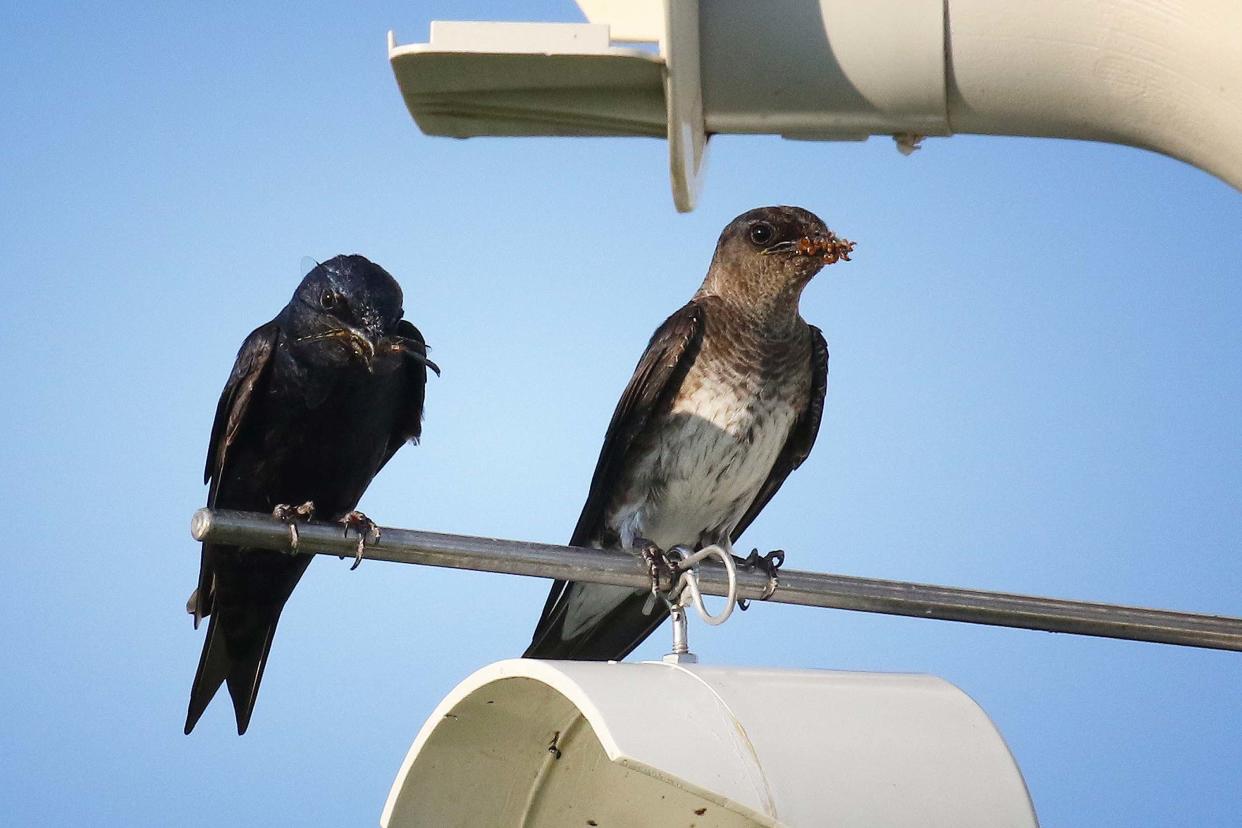Sure sign of spring: First Purple Martins spotted in Michigan for breeding season
Purple Martins are one of the most magical aerial creatures — they can catch raindrops and flying insects like dragonflies while in flight themselves. But these aerial insectivores are also a sure sign of spring when they begin to return to their breeding grounds in Michigan.
The first Purple Martins spotted in the state were seen March 17 in the City of Greenville, northeast of Grand Rapids, by a Purple Martin enthusiast, one of many who track and report on the birds' annual migration for the Purple Martin Conservation Association, a nonprofit in Erie, Pennsylvania.
Flying 7,000 miles
Purple Martins are the largest species of swallows in North America. They winter in the rainforests of Brazil before making a 7,000-mile trek to their breeding grounds in the Eastern United States and Canada, including Michigan.
An adult male is a large-breasted swallow with a slightly hooked bill and long, tapered wings and tail. They are an iridescent, dark blue-purple, smaller than a robin and bigger than a tree swallow, according to the Cornell Lab of Ornithology in Ithaca, New York. They have a wing span of up to 16 inches and typically weigh two ounces or less.
And they have been disappearing at an alarming rate, according to the Purple Martin Conservation Association. Once widespread in rural America, the species has experienced a loss of one-third of its population over the past 50 years.

Shrinking flocks
Joe Siegrist, president of the Purple Martin association, said the decline is due to a combination of factors: loss of nesting habitat, competition with invasive species, climate change and decreasing prey availability.
"Over the majority of the Purple Martins' range, they are unable to nest any longer. Human-provided nest boxes are the only thing keeping the species alive east of the Rocky Mountains," Siegrist said in a news release.
He said the species' survival is largely due to scores of dedicated conservationists who maintain "multi-compartment nest condos" for the breeding birds.
"The landlords provide critical shelter for the Martins," Siegrist said. "In return, they are rewarded with a family-like bond with the birds who return to the same colony year after year like clockwork."
Before Europeans arrived in North America, Native Americans hung up empty gourds for the Purple Martin. In the west, they still nest in places like woodpecker holes.
Martins, not robins, herald spring
The first Purple Martin arrivals of the season "are always an exciting event," Siegrist, said in a news release announcing the sightings in Greenville.
The first swallows to arrive in their breeding grounds are not scouts, but older martins returning to areas where they nested before, according to the ornithology lab at Cornell University. Those coming to breed for the first time arrive several weeks later.
The Purple Martin Conservation Association tracks the arrival of the birds with the help of about 3,500 volunteers. A smaller group of about 220 volunteers monitors the nests.
For more information, go to www.purplemartin.org.
While many observers consider the arrival of robins to be a harbinger of spring, that's not always the case. Purple Martins could be among the animal kingdom's first real sign of spring in Michigan.
Robins another sign of spring: Unraveling the winter, spring habits of Michigan robins
If you want to help a Purple Martin this summer, you might want to put out some crushed egg shells, which give the birds a source of grit for digesting the exoskeltons of the insects that they eat, according to Cornell.
While in flight, Purple Martins move rapidly with a mix of flapping and gliding. But because they feed higher in the air than other swallows, it can make them tough to spot. They like to feed in open areas, especially near water.
When it's time to return south in late summer, the Purple Martins roost together by the thousands and the gatherings are so dense they can be easily spotted on weather radar. They are especially noticeable in the early morning.
Then they're off on their 7,000-mile journey to South America and it's good bye Michigan.
Contact Jennifer Dixon: jbdixon@freepress.com
This article originally appeared on Detroit Free Press: Purple Martins return to Michigan after winter in South America
